'Natura Naturans' clarinet concerto (Tectonics 2021)
This post unpacks how the 'Natura Naturans' (mini-concerto for clarinet and prepared string orchestra) relates to the Garden of forking Paths project. See here for score and audio respectively (the solo clarinet part is at on the same PDF as the orchestra score, at the end).

'Natura Naturans' at Tectonics 2021 with Heather Roche and Ilan Volkov.
The story begins in 2019, when I received (with delight) the news that Ilan Volkov wanted me to write an orchestral piece for Tectonics Glasgow 2020, which became the piece The Dirac Sea. The COVID pandemic meant that The Dirac Sea was then rescheduled for 2021, but around February 2021 it started to become clear that while the organisers were determined to go ahead with concerts, a full orchestra would not be possible due to social distancing on-stage (and other pandemic-related logistical issues). The festival kindly offered to play a version with reduced forces, but I saw an opportunity to write a new piece that would take advantage of the social distancing both to try and give the orchestra players more space to listen, and also to bring in Heather Roche as a soloist. This meant we could try out some GoFP material in an orchestral context: something that was never in the project plan, but it would be foolish to not take such a rare opportunity. As well as bringing Heather in, I also wanted to use my new preparations for the strings; more on this at the end of this post.
Once the line-up was confirmed, the piece was then essentially written in two parts. The clarinet material was written first as a set of modular variations on a few techniques, then the orchestra part was written to create a structure and to unify the approach across strings and clarinet. It's important here to re-state some underlying compositional assumptions, that pitch is completely central to my compositional thinking, but that I'm interested in letting pitch emerge from contingent situations; not controlling specific pitches, but directing the material situation (fingerings, technique etc) such that pitches relevant to the abstract structure might emerge but in among other pitches that are part-and-parcel of that materiality (fingering, resonance, breath, etc).
Heather and I worked on the clarinet material as a solo to be performed at the Vibrant Practices symposium (called Maquette for Natura Naturans). Knowing this was ultimately for an orchestral piece, I had to take into account the limited rehearsal time, and make the clarinet material more locked-down than some GoFP pieces. Initially, I considered a modular orchestral score that could respond to contingencies in the clarinet part, but this seemed unwise in light of the tightness of orchestral rehearsal schedules. But what did make sense was for Heather to have blocks of time to explore a process, which would be fine as long as she had defined start/end points in the score. So the piece ended up as a mix of standalone gestures and long exploratory passages.
In addition to temporal fixity, the piece uses fixed fingerings (as opposed to arbitrary fingerings) and concentrates on exploration of those as resonant spaces (i.e. each fingering having a set of very-predictable and less-predictable resonances that emerge as pitches and/or multiphonics). An early decision in the piece was to have a very limited pitch structure—just G, A, B—and for the piece to unfold as a series of material-indeterminate variations on this. Essentially: the first section of the orchestra part presents an extremely slow G, A, B in clear sections; the second section is the same but each of those pitches is progressively destabilised by strings playing independently (and the G, A, B sections overlap); and the final section of the piece is completely independent, with the G, A, B atomised among a sea of related harmonics. The clarinet part repeats this principle but without the tight formal structure, instead freely departing from G, A, B fingerings in different registers.
For a 15min piece there not many fingerings, about 20 in total, which are a mix of standard pitch fingerings and nearby variant-fingerings.

Fig.2: Opening bars showing overblown fingerings: (1) high altissimo overblow, (2) no overblow, (3) 5th/7th partial harmonic overblows.
This opening passage is a good example. The first gesture is a standard C#6 fingering (transposed: all the clarinet fingerings hereafter are transposed up a tone from concert pitch), which is used a lot in this piece as well as nearby variants; e.g. the standard fingerings for A3 and E4. However, these standard fingerings are always stretched by using different embouchure/airstream techniques to activate other resonances of that fingering, they rarely only play the pitch they're known for.
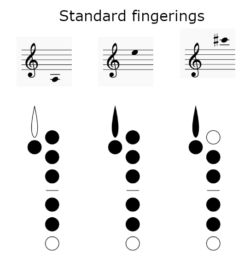
in Fig.2, Heather begins the piece by overblowing the C#6 even further than normally required for that pitch, activating two wispy and unstable harmonics above, and trying to make them sit as a chord (against their will). This is followed by a straight A3 to blend with the strings, Then the A3 is overblown: first to its 5th partial (a flattened C#6) then its 7th (which is almost a semitone flat, F#6), before a change of fundamental fingering to B3 forces a change of harmonics back down to the 5th (of B this time). These three gestures use very closely related fingerings (until the B3), all different overblowings of the A3 fundamental tube, but with different embodied techniques. The mouth position changes from very high in the first (supported by the vents [register key, and LH1* hole] in the fingering) down to standard altissimo embouchure, then standard chalumeau embouchure in the second, which in the third becomes a harmonic overblow moving across different partials. This focus on exposing and extending the technique of varying the airstream/embouchure on the same fingering is one of GoFP project's key overall outputs.

The multiphonics above in b.12 and b.15 both start in the chalumeau and gently overblow to the (sometimes) resistant clarino register; taking advantage of the mid-body single fork in those fingerings (the C# key in the former—further stabilised by added register key—and in the latter the open Bb key in the standard B3 fingerings). The resistance of this register here allows for Heather to explore a kind of parallel underblowing in the second example to flatten the harmonic and create a beating texture. In other GoFP pieces this is used to explore variation in isolating the clarino or connecting it to the higher and lower registers: fingerings with resistant clarino registers can be very useful also for exploring textures because they explore more ‘gnarly’ corners of the embouchure space.
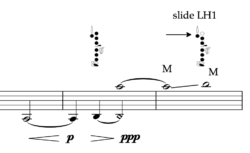
Another important GoFP technique involves very slow sliding open/closed of the holes. In this example, the notation indicates only the resultant A5–B5 movement, but in practice this was more exploratory and also produced some multiphonic tones. In wider GoFP repertoire, the exploratory nature of this can have more structural consequences. By moving the finger off the hole (or 'on' a key), a vent is opened that acts as a register key/hole. This is a standard technique for playing harmonics, and many standard altissimo fingerings are essentially vented versions of fundamental fingerings (e.g. C#6 is a vented A3-fingering with the 5th partial stabilised by LH1 open hole and the usual register key). As well as this binary (vent open or closed) approach, players often use ‘half-holes’ to stabilise altissimo pitches; a technique that is specific to the player and their instrument, finding the right size of half-hole to stabilise any given pitch. The size of 'half-' hole affects which harmonic emerges: with smaller holes tending to prefer higher harmonics but this is quite variable. Taking this further, by variably opening the hole size, the player can listen and explore the emergent harmonics and multiphonics. Combing this with different embouchure positions can produce a complex space of interactions: while in practice any given fingerings tends to produce only 2–3 harmonics (often 5th, 7th, and one of 9th or maybe higher), their interaction and varying levels of stability (and how they push each other around) is a minimal but lively space. Additionally, any given fundamental fingering may have up to six different fingers that can be half-holed in this way. The prominence of specific harmonics depends on how close the hole is to a node: in my experience, left-hand holes are more stable and often prefer 5th partial, while right-hand prefers 7th.
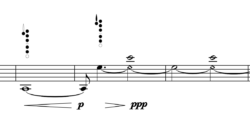
In this example, while no half-holing is notated, the movement between E5 (3rd partial of A3, supported by register key) and C6 (flat 5th partial) can be achieved entirely by embouchure, but gentle half-holing of a left-hand hole can further support and create variation in the timbre and intonations while balancing the two partials as a multiphonic.

The ‘cadenza’ also uses this technique of gradually sliding off/on holes. In Natura Naturans it was necessary to make some instances of this technique less exploratory to accommodate the situation. This technique (of all the GoFP techniques) requires especially close listening to the clarinet, which is significantly hampered by the sound of a nearby string orchestra drone: even just two clarinets holding sustained multiphonics makes it hard to hear who is playing what. However, the cadenza exists so that for a moment there is no competing sound, and Heather can concentrate on exploring the subtle shifts inside the sound. Other GoFP solo and duet pieces will explore variations on this, especially using the specifics of the emergent sounds to affect the direction of the unfolding piece.
For the rest of the concerto, the techniques listed above all return at times, but the bulk of material in the rest of the piece involves long stretches where Heather works through a single repetitive and exploratory process, usually exploring her away across registers. Much of this material can also be heard in the solo piece Maquette for Natura Naturans, written as a study for this, and performed by Heather at the Vibrant Practices symposium (video here).
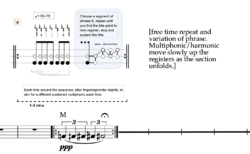
In this section, the stave notation is really only for the conductor so have they have a sense of the initial material. The register notation above, and the instructions for process, are for Heather. The register notation has been used across the whole GoFP project. The three lines of the stave indicate the registers of the instrument (chalumeau, clarino, altissimo) without specifying pitch. If a fingering is specified, then pitch is emergent from using different embodied techniques (embouchure, airstream etc) to activate the indicated register areas. The vast majority of fingerings will produce monophonic sound in all registers, with multiphonic sound being possible in all fingerings but with some limitations on which registers will connect, and the character and stability of that connection. The register notation is also quasi-graphic, where variations on noteheads and connectors imply different types of sound and hierarchy of registers to be aimed for in performance.
Two more sections take this approach, alongside a relatively sparse string section to let Heather hear more clearly, and to let the detail come through. Listening and responding to the instrument become more important in these sections, as these are key GoFP elements.
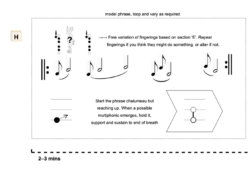
In this example, the lower instruction is vital since it sets the listening conditions: ‘When a possible multiphonic emerges, hold it, support and sustain to end of breath’. The rhythm/phrase notation provides a basis for beginning to improvise with the given fingerings, but the listening conditions drive decision-making and responsiveness. The stave notation sets action in motion through an unstable space, and the contingent results of these actions provide opportunities for Heather to project emergent stabilities.

After these long responsive sections, the final section of the piece is more determinate, because it’s with the full string orchestra so listening (and therefore exploration) is less easy. This is a variation sequence, where register exploration forms the variation. The same sequence of fingerings are (more or less) repeated multiple times, but with different approaches to register, both monophonic and multiphonic. The different register approaches also mean that the shape of the melody may change because each fingering has its own thresholds between resonance sensitivities. For example, with a slightly different embouchure that ‘pushes up’, the C#6 fingering in b.141 will still sound C#6 but the B5 in b.142 is likely to jump upwards to the next harmonic (why? who knows... the interactions are complex here). This situation of responding to emergent stabilities will be key for the final phase of GoFP and its outputs. This largely determinate large-ensemble piece provides the basis for more indeterminate chamber pieces going forward.
One last brief point on the string orchestra part. There's two main techniques here, both mirroring the clarinet technique of using the instrument materiality to create indeterminate variations on basic material. The first technique uses only natural harmonics, and leans on John Lely's The Harmonics of Real Strings. Here the instruments begin on fixed harmonics, then move off those harmonics very gently, exploring the nearby physical space to find other stable harmonics: the emergence of specific harmonics is highly dependent on bow position, which can be subtly different for each string and finger-position. Across the piece, these explorations become more distant, and more independent (in temporal terms). The second technique uses 'preparations' (like Cage's 'prepared piano'), wooden rings that couple two strings together to create unstable resonances that result in both multiphonic and monophonic pitch-complexes. The rings are placed at specific points on the string so that they are likely to produce a certain pitch, but players are increasing instructed to seek out other pitches (without moving the ring) using variations in bow position/speed/pressure/etc. The preparations have also been used in my piece The whole is encountered by going further into the parts (2020) for solo prepared contrabass, written for Christopher Williams: see here for score and recording.

LH1 = left hand, first/index finger
